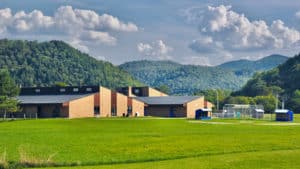Town Meeting Day vote will ask voters if it’s worth $1
By Ethan Weinstein/VTDigger
This summer and beyond, residents of the town of Rochester are trying to figure out what to do with an empty high school building — four years after its last class graduated.
Following the district mergers and school consolidations that resulted from the passage of Act 46, Rochester, like several other small communities, saw its local high school become obsolete. In RHS’s final year, the school had just two high school students. After graduating its final class in 2018, the school ceased operations.

The former Rochester High School ceased regular operations in 2018, the building remains empty.
“The high school closure was a sort of a signal event to the community that things are not heading in a good direction. We need to do something different,” said Vic Ribaudo, co-chair of the Rochester High School Repurposing Committee, which formed in 2020 to lead the process of figuring out what to do with almost 26,500 square feet of usable space.
The northern White River Valley town of about 1,100 had operated an incorporated high school since 1886. The current high school, built in 1974, lies alongside the White River behind Rochester’s still operating an elementary school for pre-K through sixth grade. After a 290-11 vote in 2017, Rochester joined with Stockbridge to form a unified district with two elementary schools that tuitions students to other districts or private schools for middle and high school. As part of that merger, the towns agreed that Rochester could purchase its high school for $1 after the school closed.
This summer, a feasibility study outlined the details associated with repurposing the school into a multi-use community center and business space. Among the potential tenants: child care, senior services, light manufacturing, arts organizations, health care and an outdoor recreation program.
Ribaudo, co-chair Kathryn Schenkman and committee members are working closely with the Rochester Selectboard and Rochester-Stockbridge Unified School District, which still owns the property, to determine next steps.
Pat Harvey, a member of Rochester’s Select Board, said the town expects to vote on whether to purchase the high school in March 2023.
The economics are challenging. The study suggests that in order for a repurposed version of the high school to make financial sense, the building needs upwards of $3.1 million in updates. The proposed community center would also require one or two “anchor tenants,” whose higher rent would provide a steady income stream to fund the estimated annual operating expenses, adjusted for inflation, of $110,000 to make the initiative economically viable. One possible anchor tenant suggested by the feasibility study is the town itself.
The committee also recently learned that part of the school property sits inside the White River’s floodway, which precludes the site from receiving certain state and federal funding, Schenkman explained. But according to Schenkman, because it’s only a sliver and does not include the high school building itself, the project might still receive funding with additional documentation, or by subdividing out the floodway portion.
The committee is planning further environmental assessments necessary for grant proposals. The assessment will, among other things, determine the potential environmental effects associated with a 10,000-gallon fuel tank buried on the property. Currently, the group is searching for a project manager to handle further administrative work.
Other towns with retired schools have transformed the buildings for alternative uses. Wilmington has turned the former Twin Valley High School into the Old School Community Center, which has undergone a continued development into a multi-use community space. In Springfield, the Park Street School functions as part school administrative space, part start-up innovation center, with plans for further development and millions of federal dollars on the way.
Nestled in the Green Mountains, Rochester has become a regional recreation hub alongside the other ‘Quintown Valley’ towns of Hancock, Granville, Stockbridge and Pittsfield. The Ridgeline Outdoor Collective, based in Rochester, has helped create, maintain and promote mountain biking and backcountry ski trails in the area.
The combination of sports makes the town a year-round outdoor destination. Ribaudo and Schenkman believe the town can leverage that appeal to attract more young people to the area. A community center would only add to the draw, they said.
“We think that this one item can really enhance the quality of life in this community and make it more attractive,” Ribaudo said.
In recent years, the high school has been used to host town meetings and artistic events like the Green Mountain Suzuki Institute’s summer music camp. Investing in repurposing the high school would create a nucleus for increased community engagement, its advocates say.
“The school has been a primary place for not only education, but social engagement, town government and any myriad of things, right?” Schenkman said. “It’s a cultural center and now they want to actually just develop it as that, a lifelong learning and cultural center to serve the Quintown area and beyond.”
Harvey said she is waiting for more information to make up her mind about the future of the high school, but she lauded the work of the repurposing committee and other townspeople in advancing the community center idea. “It seems as though we take one step forward, and two steps back. But the determination of the people in the Valley to make this work is relentless,” she said.




